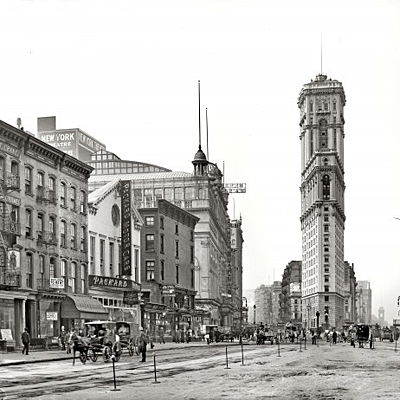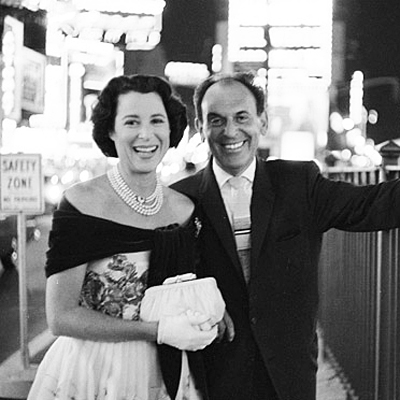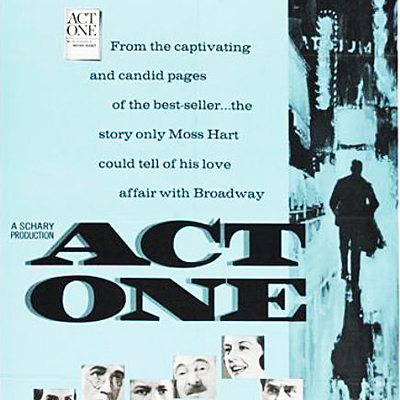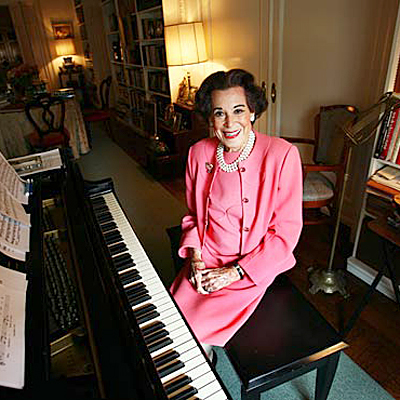Behind the Curtain of Act One! Chart Theater Legend Moss Hart’s Extraordinary Journey to Broadway
Get ready for a little Broadway on Broadway! Act One is based on the autobiography of famed playwright, director and storyteller Moss Hart, which chronicles his astonishing rise from poverty to his first Broadway hit (of many) in 1930. Don't worry, this isn't a dry history play—Hart always had an ear for drama and told his story in the most glamorous, theatrical way possible. Read on below for a look at the life of one of Broadway's greats, and find out how his iconic showbiz memoir went from page to stage at Lincoln Center, starring Santino Fontana, Tony Shalhoub and Andrea Martin.

Curtain Up: Humble Beginnings
Though Moss Hart liked to joke that he was born on "the wrong end" of Fifth Avenue, he was actually born in a tenement at 74 E. 105th Street in 1904, growing up in "an atmosphere of unrelieved poverty," according to The Life and Times of Moss Hart. His eccentric Aunt Kate, who would pull him out of school to see matinees, gave Hart his love of the theater. In Act One, Hart writes that she died while he was out of town with his first play, The Beloved Bandit—in reality, she became mentally unstable and plagued Hart in his later life, including allegedly setting fires backstage at his Broadway show Jubilee.

Fake It 'Til You Make It
To support his impoverished family, Hart dropped out of school—at 14, he got a job in the storage vault of a wholesale furrier. After toiling away for two years, Hart finally got to Broadway (near, anyway) when he landed a job as an office boy to producer Augustus Pitou, Jr. The young assistant sneakily submitted his first play, The Beloved Bandit, to Pitou under a pen name. It was such a disastrous flop, the ordeal ended up costing the producer $45,000. Hart was fired.

Chance of a Lifetime
At age 24, Hart wrote Once in a Lifetime, a satire of the film industry's harried transition to talkies. It attracted the attention of producer Sam H. Harris, who agreed to take it on if Hart would rework it with George S. Kaufman—a big yes for Hart, who had long admired the legendary playwright. The process took six months, and was still in bad shape during out-of-town tryouts, but in 1930, Once in a Lifetime opened on Broadway to rave reviews. As Hart tells the story, he went straight to his family's dingy home in Sea Gate, Brooklyn, and whisked everyone away to live at the Ansonia Hotel in Manhattan. So ends Act One the book, but there was much more to come from Hart himself.

Keep 'Em Coming
At only 26 years old, Hart was dubbed "the Prince of Broadway" by columnist Leonard Lyons. Hart and Kaufman would go on to write shows like Merrily We Roll Along, I'd Rather Be Right and The Man Who Came to Dinner. Hart was just as prolific after their 10-year partnership ended; he would later write with Irving Berlin (Face the Music, As Thousands Cheer), and on his own (Lady in the Dark), direct My Fair Lady (for which he won his only Tony Award) and Camelot, and pen such screenplays as Gentleman's Agreement and the Judy Garland vehicle A Star is Born.

And the Award Goes To...
Of their many collaborations, Hart and Kaufman's greatest success was the play You Can't Take It With You. The pair won the 1937 Pulitzer Prize for drama, and a berjillion high school and regional theater productions were born. A year after their big literary win, Hart and Kaufman adapted the play for the silver screen. Starring Jimmy Stewart and Lionel Barrymore and directed by Frank Capra, You Can't Take It With You won the 1938 Academy Award for Best Picture.

Hey, Big Spender
By 1943, Hart had made over a million dollars. Of Hart's country estate, a houseguest once supposedly said, "It shows you what God would have done if he'd had the money." Among the luxuries he owned? An electric toothbrush, air conditioners, televisions, radio-phonographs for piping music around his houses (remember: 1943), elephant tusks, a collection of star sapphires, and "a pair of red doeskin slacks marked down to a hundred dollars at an Abercrombie & Fitch sale," according to The New Yorker.

Falling In Love, Literally
Hart met actress and singer Kitty Carlisle on the set of the Marx Brothers' A Night at the Opera, where he was looking for a leading lady. Carlisle heard that Hart wanted to meet her, and ran so fast that she fell in a heap at his feet. He didn't cast her. The two didn't meet again until many years later at a party at Lillian Hellman's house, and were married on August 10, 1946.

Was Hart In the Closet?
Given his lengthy bachelor period, rumors had long circulated about Hart's sexuality. These rumors were raised in a 1993 New Yorker interview with Kitty, who said that she'd asked him outright while they were dating, “Are you homosexual?” He answered, “absolutely not.” Kitty said she “never gave it another thought.” Hart's biographer Steven Bach, however, put it this way: "If sex was one of his demons, it was one he seemed able to control."

You Really Can't Take It With You
Act One was a colossal hit when it was published in 1959; Time magazine called it “one of the best memoirs of this or any other theatrical generation.” Though Hart ended his memoir with the phrase "Intermission," he never got a chance to write his own second act. He died of a heart attack on December 20, 1961 at the age of 57.

The Film Was a Flop
In 1963, a film adaptation of Act One was released, directed by Hart's longtime friend Dore Schary, and starring George Hamilton as Hart and Jason Robards as Kaufman. While Bosley Crowther of The New York Times acknowledged Schary's good intentions, he still called it "a picture of a patent-leather dullard trying to peddle and then rewrite a play with the help of a cranky old codger who is almost as dull as he." Ouch!

Kitty's Out of the Bag
Kitty Carlisle Hart spent her life protecting the legacy of her late husband, which included keeping the diary he kept from 1953-54— written during one of his many bouts of crippling depression and writer's block—under wraps until after her death. When she passed away in 2007, the diary, which cast a critical eye on his peers, was made public: Greta Garbo? "Old and pinched." Dorothy Parker? "Bitter and acid." Audrey Hepburn? "Absolutely ruthless."

Act One Gets a New Chapter
Now, 74 years after Hart's first Broadway hit, James Lapine (Into the Woods, Sunday in the Park with George) directs his own adaptation of this ode to the theater, starring Tony Shalhoub, Santino Fontana and Andrea Martin. “The book is so iconic," Lapine told Broadway.com. "It’s such a love letter to our theater, our world and our profession. It seemed like a natural—I wanted to bring it to life.” The Lincoln Center Theater production opens on April 17 at the Vivian Beaumont Theater. Places, everyone!
Related Shows
Star Files
Articles Trending Now
- 2025 Drama League Nominations Announced; Idina Menzel, Helen J Shen, Nicole Scherzinger, Lea Salonga and More Up for Awards
- Tony Winners Wendell Pierce and Sarah Paulson Will Announce 2025 Tony Nominations
- Redwood, Starring Idina Menzel, Will Release an Original Broadway Cast Recording in May; Debut Track Out Today



